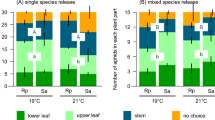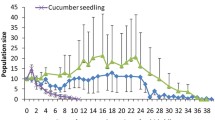Abstract
To forecast the effects of climate change and extreme temperature events on insect population dynamics, the high-temperature tolerance of insects must be taken into account. We compared the life-history characteristics of cowpea aphid (Aphis craccivora Koch) across different temperature regimes on two different host plants, soybean (a preferred host) and cotton (a non-preferred host). Most demographic parameters were superior for the aphid on soybean than on cotton. Temperatures affected aphid development more on cotton than on soybean. The intrinsic rate of increase, reproduction rate, number of progeny per adult, and longevity were significantly higher on soybean than on cotton for the same temperature regime. Temperatures that fluctuated to extreme levels caused a rapid decline in each of these parameters for aphids fed on cotton, but not for those fed on soybean. To our knowledge, this is the first report to note that the high-temperature tolerance of A. craccivora is host-specific (cotton vs. soybean). Our findings may partly explain the observed niche switching of the cowpea aphid (Aphis craccivora) from cotton to soybean at the beginning of summer when the temperature goes up in the Xinjiang cotton-growing zone (Northwest China). This host mediation of high-temperature tolerance in aphids should be taken into account when modeling population dynamics under the influence of global warming, host adaptation, and the risk analysis of alien pest invasions.



Similar content being viewed by others
References
Abdou WL, Abdel-Hakim EA, Salem NY, Mansour MH, Amr EM (2012) Estimation of economic injury level of Aphis craccivora Koch. (Homoptera: Aphididae) infesting faba bean in new reclaimed area. Arch Phytopathol Plant Prot 45:1764–1772
Addo-Bediako A, Chown SL, Gaston KJ (2000) Thermal tolerance, climatic variability and latitude. P Roy Lond B Biol 267:739–745
Asin L, Pons X (2001) Effect of high temperature on the growth and reproduction of corn aphids (Homoptera: Aphididae) and implications for their population dynamics on the northeaster Iberian Peninsula. Environ Entomol 30:1127–1134
Awmack CS, Leather SR (2002) Host plant quality and fecundity in herbivorous insects. Annu Rev Entomol 47:817–844
Baldwin WF (1954) Acclimation and lethal high temperatures for a parasitic insect. Can J Zool 32:157–171
Bale JS, Masters GJ, Hodkinson ID et al (2002) Herbivory in global climate change research: direct effects of rising temperature on insect herbivores. Glob Change Biol 8:1–16
Beever EA, Ray C, Wilkening JL, Brussard PF, Mote PW (2011) Contemporary climate change alters the pace and drivers of extinction. Glob Change Biol 17:2054–2070
Berberet RC, Giles KL, Zarrabi AA, Payton ME (2009) Development, reproduction, and within-plant infestation patterns of Aphis craccivora (Homoptera: Aphididae) on alfalfa. Environ Entomol 38:1765–1771
Berg GN (1984) The effect of temperature and host species on the population growth potential of the cowpea aphid, Aphis craccivora Koch (Homoptera: Aphididae). Aust J Zool 32:345–352
Bernardo EN (1969) Effects of six host plants on the biology of black bean aphid, Aphis craccivora Koch. Philipp Entomol 1:287–292
Birch LC (1948) The intrinsic rate of natural increase of an insect population. J Anim Ecol 17:15–26
Blackman RL, Eastop VF (2000) Aphids on the world’s crops: an identification and information guide, 2nd edn. Wiley, New York, p 466
Botkin DB, Saxe H, Araújo MB et al (2007) Forecasting the effects of global warming on biodiversity. Bioscience 57:227–236
Bowler K, Terblanche JS (2008) Insect thermal tolerance: what is the role of ontogeny, ageing and senescence? Biol Rev Camb Philos Soc 83:339–355
Burke G, Fiehn O, Moran N (2010) Effects of facultative symbionts and heat stress on the metabolome of pea aphids. ISME J 4:242–252
Calosi P, Bilton DT, Spicer JI (2008) Thermal tolerance, acclimatory capacity and vulnerability to global climate change. Biol Lett 4:99–102
Chen DQ, Purcell AH (1997) Occurrence and transmission of facultative endosymbionts in aphids. Curr Microbiol 34:220–225
Chen CY, Lai CY, Kuo MH (2009) Temperature effect on the growth of Buchnera endosymbiont in Aphis craccivora (Hemiptera: Aphididae). Symbiosis 49:53–59
Chen CY, Chiu MC, Kuo MH (2013) Effect of warming with temperature oscillations on a low-latitude aphid, Aphis craccivora. Bull Entomol Res 103:406–413
Colinet H, Sinclair BJ, Vernon P, Renault D (2015) Insects in fluctuating thermal environments. Annu Rev Entomol 60:123–140
Dean GJ (1974) Effect of temperature on the cereal aphids Metopolophium dirhodum (Wlk.), Rhopalosiphum padi (L.) and Macrosiphum avenue (F.) (Hem., Aphididae). Bull Entomol Res 63:401–409
Diamond SE, Kingsolver JG (2012) Host plant adaptation and the evolution of thermal reaction norms. Oecologia 169:53–360
Dixon AFG, Honek A, Keil P, Kotela MAA, Sizling AL, Jarosik V (2009) Relationship between the minimum and maximum temperature thresholds for development in insects. Funct Ecol 2:257–264
Dunbar HE, Wilson AC, Ferquson NR, Moran NA (2007) Aphid thermal tolerance is governed by a point mutation in bacterial symbionts. PLoS Biol 5:1006–1015
Firempong S (1988) Components of resistance to Aphis craccivora in some cowpea cultivars. Entomol Exp Appl 48:241–246
Gao GZ, Perkins LE, Zalucki MP, Lu ZZ, Ma JH (2013) Effect of temperature on the biology of Acyrthosiphon gossypii Mordvilko (Homoptera: Aphididae) on cotton. J Pest Sci 86:167–172
Golizadeh A, Jafari-Behi V (2012) Biological traits and life table parameters of variegated lady beetle, Hippodamia variegata (Coleoptera: Coccinellidae) on three aphid species. Appl Entomol Zool 47(3):199–205
Grüber K, Dixon AFG (1988) The effect of nutrient stress on development and reproduction in an aphid. Entomol Exp Appl 47:23–30
Guo HM, Wen LZ (1999) Studies on yield loss and dynamics economic threshold of cowpea aphid Aphis craccivora Koch on cowpea, Vigna sp. J Hunan Agric Univ 25:137–142
Gutierrez AP, Morgan DJ, Havenstein DE (1971) The ecology of Aphis craccivora Koch and subterranean clover stunt virus. 1. The phenology of aphid populations and the epidemiology of virus in pastures in south-east Australia. J Appl Ecol 8:699–721
Gutierrez AP, Havenstein DE, Nix HA, Moore PA (1974) The ecology of Aphis craccivora Koch and subterranean clover stunt virus in south-east Australia. II. A model of cowpea aphid populations in temperate pastures. J Appl Ecol 11:1–20
Han P, Niu CY, Desneux N (2014) Identification of top-down forces regulating cotton aphid population growth in transgenic Bt cotton in central China. PLoS One 9(8):e102980
Han P, Bearez P, Adamowicz S, Lavoir AV, Desneux N (2015a) Nitrogen and water limitations in tomato plants trigger negative bottom-up effects on the omnivorous predator Macrolophus pygmaeus. J Pest Sci 88:685–691. doi:10.1007/s10340-015-0662-2 (in press)
Han P, Dong YC, Lavoir AV, Adamowicz S, Bearez P, Wajnberg E, Desneux N (2015b) Effect of plant nitrogen and water status on the foraging behavior and fitness of an omnivorous arthropod. Ecol Evol 5:5468–5477. doi:10.1002/ece3.1788 (in press)
Harrington R, Clark SJ, Welham SJ et al (2007) Environmental change and the phenology of European aphids. Global Change Biol 13:1550–1564
Huey RB, Berrigan D (2001) Temperature, demography, and ectotherm fitness. Am Nat 158:204–210
Huguenot C, Furneaux MT, Thottappilly G, Rossel HW, Hamilton RI (1993) Evidence that cowpea aphid-borne mosaic and blackeye cowpea mosaic viruses are two different potyviruses. J Gen Virol 74:335–340
Hull R (1964) Spread of groundnut rosette virus by Aphis craccivora (Koch). Nature 202:213–214
Ji F, Wu ZH, Huang JP, Chassignet EP (2014) Evolution of land surface air temperature trend. Nat Clim Change 4:462–466
Johnson B (1953) The injurious effects of the hooked epidermal hairs of French beans (Phaseolus vulgaris L.) on Aphis craccivora Koch. Bull Entomol Res 44:779–788
Kuo MH, Chen CY (2004) Development and population parameters of the cowpea aphid, Aphis craccivora Koch (Hemiptera: Aphididae), at various constant temperatures. Formosan Entomol 244:305–315
Kuo MH, Lu WN, Chiu MC, Kuo YH, Hwang SH (2006) Temperature-dependent development and population growth of Tetraneura nigriabdominalis (Homoptera : Pemphigidae) on three host plants. J Econ Entomol 99:1209–1213
Lu Y, Li J, Wang PL (2011) Cotton resistance to aphids, induced by the Aphis craccivora. Plant Prot 37:116–119
Lu YH, Wu KM, Jiang YY, Guo YY, Desneux N (2012) Widespread adoption of Bt cotton and insecticide decrease promotes biocontrol services. Nature 487:362–365
Ma CS, Hau B, Poehling HM (2004) Effects of pattern and timing of high temperature exposure on reproduction of the rose grain aphid, Metopolophium dirhodum. Entomol Exp Appl 110:65–71
Narzikulov MN, Shomirsaidov SH (1975) News about amphigonic generation of groundnut Aphis craccivora Koch (Homopt. Aphididae) in Tajikistan. In: Narzikulov MN (ed) Proceedings of AN Tajik SSR. AN Tajik, Dushanbe, p 4651 (in Russian)
Newman JA (2004) Climate change and cereal aphids: the relative effects of increasing CO2 and temperature on aphid population dynamics. Glob Change Biol 10:5–15
Obopile M, Ositile B (2010) Life table and population parameters of cowpea aphid, Aphis craccivora Koch (Homoptera: Aphididae) on five cowpea Vigna unguiculata (L. Walp.) varieties. J Pest Sci 83:9–14
Pucherelli SF, Peairs FB, Merrill SC, Randolph TL (2012) Russian wheat aphid (Hemiptera: Aphididae) reproduction and development on five noncultivated grass hosts. Arthropod Plant Interact 6:67–73
Radke SG, Benton AW, Yendol WG (1975) Effect of temperature and light on the development of cowpea aphid, Aphis craccivora Koch. Indian J Entomol 35:107–118
Soffan A, Aldawood AS (2014) Biology and demographic growth parameters of cowpea aphid (Aphis craccivora) on faba bean (Vicia faba) cultivars. J Insect Sci 14:1–10
Stoetzel MB, Miller GL, O’Brien PJ, Graves JB (1996) Aphids (Homoptera: Aphididae) colonizing cotton in the United States. Fla Entomol 79:193–205
Sutherst RW, Maywald GF (2005) A climate model of the red imported fire ant, Solenopsis invicta Buren (Hymenoptera: Formicidae): implications for invasion of new regions, particularly Oceania. Environ Entomol 34:317–335
Sutherst RW, Constable F, Finlay KJ, Harrington R, Luck J, Zalucki MP (2011) Adapting to crop pest and pathogen risks under a changing climate. Clim Change 2:220–237
Tang YQ, Lapointe SL, Brown LG, Hunter WB (1999) Effects of host plant and temperature on the biology of Toxoptera citricida (Homoptera: Aphididae). Environ Entomol 28:895–900
Terblanche JS, Hoffmann AA, Mitchell KA, Rako L, le Roux PC, Chown SL (2011) Ecologically relevant measures of tolerance to potentially lethal temperatures. J Exp Biol 214:3713–3725
Turak E, Talent R, Sunnucks P, Hales DF (1998) Different responses to temperature in three closely-related sympatric cereal aphids. Entomol Exp Appl 86:49–58
Whalen R, Harmon JP (2015) Temperature alters the interaction between a herbivore and a resistant host plant. Arthropod Plant Inte 9:233–240
Zalucki MP, Van Klinken RD (2006) Predicting population dynamics of weed biological control agents: science or gazing into crystal balls? Aust J Entomol 45:330–343
Acknowledgments
This work was supported by the International S&T Cooperation Program of China (2011DFA33170) and the National Natural Science Foundation of China (31301673).
Author information
Authors and Affiliations
Corresponding author
Additional information
Feng Likai is a joint first author due to his contribution to this project.
Rights and permissions
About this article
Cite this article
Zhaozhi, L., Likai, F., Guizhen, G. et al. Differences in the high-temperature tolerance of Aphis craccivora (Hemiptera: Aphididae) on cotton and soybean: implications for ecological niche switching among hosts. Appl Entomol Zool 52, 9–18 (2017). https://doi.org/10.1007/s13355-016-0446-z
Received:
Accepted:
Published:
Issue Date:
DOI: https://doi.org/10.1007/s13355-016-0446-z




